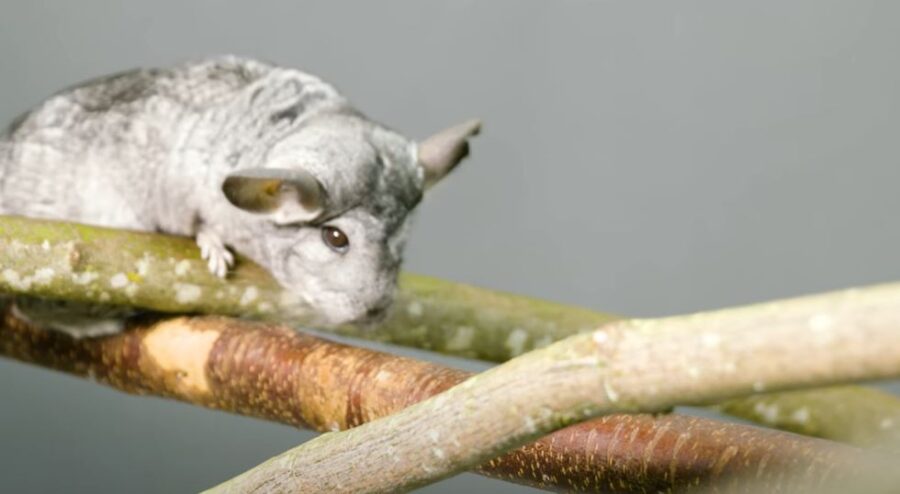Do chinchillas get cold in our homes? How to tell if your chinchilla is cold is more difficult than knowing when they are hot.
Allow me to explain temperature requirements, tips for how to keep them warm and all about the risks involving when taking them outside to play in the winter.
How to Tell if Your Chinchilla Is Cold
The only time I noticed that my chinchillas were too cold was when they were more sluggish, lethargic and reduced eating as much as they normally do.
It was because they were at a drafty location that caused the cold sensation for animals that are otherwise highly tolerant of cooler temperatures.
It’s unlikely that your house will ever become chilly enough for a chinchilla. A chinchilla can survive at temperatures as low as 50 degrees Fahrenheit. Below that point, they start to have respiratory infections, which can be fatal if they develop into pneumonia or become progressively worse.

How Do You Warm up a Chinchilla?
Warming up a chinchilla isn’t as crucial as cooling them down. Their fur keeps them warm in cold climates, but it can cause overheating.
A chinchilla cage doesn’t need to be kept warm. Move your chinchilla’s cage if it is currently located in a cold location. As long as the cage is not exposed to bright sunlight or a chilly draft, any interior area should be suitable.
To cool down a chinchilla requires cold tiles to be placed in their enclosure or look out for a stone-based product called a “chin chiller”.
What to Do if My Chinchilla Has a Cold?
A visit to the vet is recommended for a chinchilla experiencing a:
- cold or respiratory problem
- lack of appetite
- abnormal behavior that is prolonged for 2-3 days.
Antibiotics and general supportive care are included in the treatment, which also involves gently washing the nose and eyes with warm water compresses and removing any crusts that may have formed.
Do Chinchillas Get Cold Easily?
No. The opposite is true. Chinchillas do not perform well in environments with high temperatures or high levels of humidity due to their thick fur coats.
In a perfect world, their enclosure would be situated in a room that was both cold and dry, and it would also have sufficient ventilation.
Temperatures between 60 and 75 degrees Fahrenheit and relative humidity of less than 60 percent should be maintained at all times for optimal comfort.
How Do I Know if My Chinchilla Is Too Hot?
The most evident indicator that your chinchilla can be overheated is if their ears become bright red.
If you see that their ears are red, you should examine the blood vessels in their ears to see if there are any indications of swelling. This is another clue that they may be overheating.

What’s the Coldest a Chinchilla Can Be In?
The temperature of the room in your home where you keep your chinchilla should be between 64 and 70 degrees Fahrenheit at all times.
- I do not advocate temperatures lower than 64 degrees.
- A chinchilla can withstand temperatures as low as 25 to 40 degrees Fahrenheit (-4 to 4.5 degrees Celsius).
Although it would be uncomfortable for you, it is doubtful that your house will ever experience such low temperatures.
- Your chinchilla may start to get respiratory problems and their metabolism may start to slow down if the temperature starts to decrease quickly without allowing them time to acclimate to the changes in temperature.
- As captive-bred chinchillas were not raised in the wild, they have not developed the necessary thermal tolerance.
- In order to maintain body heat during this period in the wild, chinchillas will keep themselves warm in burrows or rock crevices where they would snuggle with their colony.
Are Chinchillas Sensitive to Cold?
No. Chinchillas have a high tolerance for the cold, but they cannot stand the heat. Chinchillas are able to survive in temperatures ranging from 65 degrees Fahrenheit to 80 degrees Fahrenheit (18.3 degrees Celsius to 26.7 degrees Celsius).
Heatstroke can occur when your pocket pet is subjected to greater ambient temperatures, particularly when there is also a significant level of humidity present.
What Temperature Should a Chinchilla’s Room Be?
When exposed to temperatures that are higher than 26.7 degrees Celsius (80 degrees Fahrenheit), chinchillas are likely to perish from heat stress.
The optimal range for holding temperatures and ambient temperatures is between 18.3-26.7 degrees Celsius (59 and 70 degrees Fahrenheit).

Is My Chinchilla Too Cold?
I had recently relocated my chinchillas to a spare bedroom in the belief that they would benefit from the quiet and window view. They became increasingly lethargic and didn’t eat as much.
I relocated them to the area that was intended to be the dining room, and now they seem to be functioning normally again. Even though they seemed to be well, I continued to be concerned about the cold.
I draped a towel over the top of the cage to provide a bit of cover for them and also noticed that I could block the draft that was coming in from the hallway. All in all, the location of the enclosure really matters when trying to regulate the temperature of your chinchillas.
Can Chinchillas Be Kept Outside?
No. For a number of reasons, it is recommended to prevent keeping your chinchilla outside. If you keep your chinchilla outside, you are exposing it to elements to which it is not used to.
You most likely don’t reside in the Andes Mountains or even in the region where chinchillas were first discovered.
- If you keep your chinchilla outside, away from the safety of your home, the temperature in your location will be abnormal and uncomfortable for them.
- The scathing sun and wind might have a severe impact on them, putting your chinchilla in agony.
- Other issues might arise if predators and dangerous plants or seeds penetrate the habitat of your chinchilla.
In order to protect your chinchilla from the weather and any predators, it is advised to keep them indoors and away from open doors and windows.
Can Chinchillas Go In Snow?
It is not advised to do this, despite the cute footage of chinchillas racing through the snow that have been circulating online. Because their coats are not designed to withstand snow, chinchillas may find it uncomfortable.
Chinchillas will not come into direct contact with snow in the wild and they would much rather stay warm in a burrow with their colony than play in it.
Snow will add to the moisture that creates wetness on their fur or skin that could lead to skin infections as well.
Thank you for visiting PocketPetCentral.com for the best information to help you enjoy the life of your pocket pet companion in a fun, safe & healthy way.

